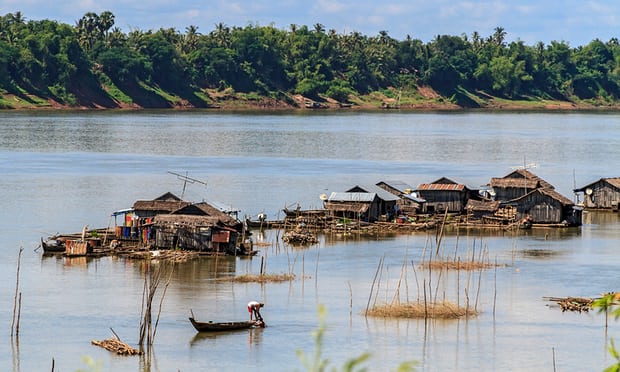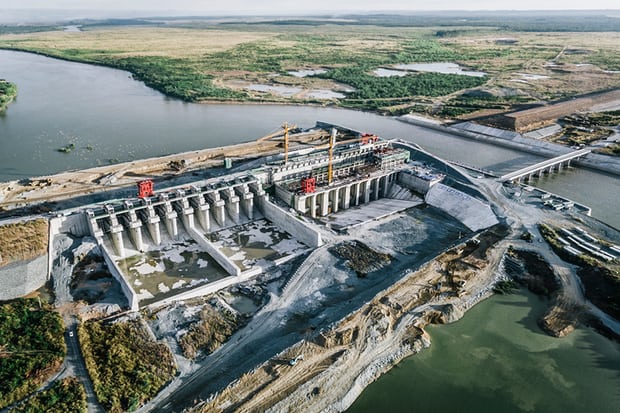Government-commissioned report says proposed site at Sambor reach is the ‘worst possible place’ for hydropower due to impact on wildlife.
 The report warns that the proposed dam in Kratie would devastate fisheries that many communities rely on. Photograph: Yvette Cardozo/Alamy
The report warns that the proposed dam in Kratie would devastate fisheries that many communities rely on. Photograph: Yvette Cardozo/Alamy
A Chinese-backed plan to build Cambodia’s biggest dam could “literally kill” the Mekong river, according to a confidential assessment seen by the Guardian which says that the proposed site at Sambor is the “worst possible place” for hydropower.
The report, which was commissioned by the government in Phnom Penh, has been kept secret since it was submitted last year, prompting concerns that ministers are inclined to push ahead regardless of the dire impact it predicts on river dolphins and one of the world’s largest migrations of freshwater fish.
The proposed hydropower plant would require an 18km-wide barrier across the river at Sambor, Kratie province. This quiet rural district is best known as a place for watching Irrawaddy dolphins, whose critically low numbers have just shown their first increase in 20 years.
To examine the environmental impact of the dam and the 82km-long reservoir that would form behind it, the Cambodian government commissioned the National Heritage Institute, a US-based research, and consultancy firm, to undertake a three-year study in 2014.
But it has refused to make public the results of the Sambor Hydropower Dam Alternatives Assessment, despite numerous appeals from civil society organizations. A copy has now been leaked to the Guardian.
In its key findings, the report notes: “The impact on fisheries would be devastating as it would block fish migration from the Tonle Sap (Cambodia’s Great Lake), a vital tributary to the Mekong and the spawning grounds upstream.”
The Mekong is the world’s most productive inland fishery, sustaining the food security of 60 million people. The Mekong River Commission puts the value of wild-capture fish at $11b n, shared between the four member states of Cambodia, Laos, Thailand and Vietnam.
The stakes are very high for a country where 80% of Cambodians count on fish as their main source of protein.
It is also a potential game-changer for other species in the Mekong’s ecosystem. Marc Goichot, WWF’s water resources specialist, said: “After 15 years WWF and our Cambodian partners are finally winning the battle to conserve Mekong dolphins with 15 new calves born since 2015. A Sambor dam would ruin all those efforts. Together with the plight of the dolphins, fisheries, livelihoods, and nutrition of rural communities would all suffer, as well as precipitating the sinking of the Mekong Delta in Vietnam.”
The plan for the dam dates back to a memorandum of understanding signed with China Southern Power Grid in 2006. Widespread opposition prompted the Chinese investor to withdrew from the project in 2008.
The country’s chronic energy shortage, high prices, and its 50% import dependency prompted the government to revive the Sambor project in 2016, after Laos had already launched two controversial dams upstream - the Xayaburi and the Don Sahong dams.
In the executive summary, the report declares “a dam at this site could literally kill the river unless sited, designed and operated sustainably. The Sambor reach is the worst possible place to build a major dam.”
Cambodia’s deputy minister of energy, Ith Praing, said: “It is a very sensitive issue and too early to publish any kind of information on Sambor.”
The survey team looked at 10 alternative locations for a Sambor dam site by deploying the world’s most advanced mitigation technology. The project director, Gregory Thomas, said: “Even the most advanced mitigation measures still pose high risks. There is no evidence that any large dam on a tropical river has ever been successful in the use of the latest fish mitigation technology.”
In place of a new dam, the study recommends integrating floating solar photovoltaic panels into the already operational Lower Sesan 2 dam and operating the reservoir as a single integrated hybrid facility. Power capacity would be doubled to more than 800MW. This technique of augmenting existing hydropower facilities with solar photovoltaics plants has been widely developed in China and India.
 An aerial view of the now operational Lower Sesan 2 Dam while it was under construction. Photograph: Sion Ang/SOPA Images/LightRocket/Getty Images
An aerial view of the now operational Lower Sesan 2 Dam while it was under construction. Photograph: Sion Ang/SOPA Images/LightRocket/Getty Images
According to the report, “solar energy is the only option with a positive net economic benefit after all costs and benefits are taken into account, and the cost of solar would be cheaper than the best possible mitigated dam”.
Cambodia’s Energy Ministry has so far taken only small steps in the direction of solar energy and has given a tepid response to the 400MW solar proposal, which suggests it is still batting for a mitigated dam.
Praing said no decision would be taken until after July’s general election. If the dam is approved, the leading candidate to build it is China’s Hydrolancang International Energy Company.









